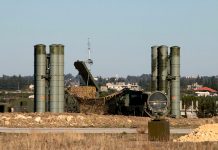
China’s naval capabilities have reached a significant milestone with the commencement of sea trials for its latest aircraft carrier, the Fujian. Recent video footage, shared by Clash Report, captures the carrier departing from dry dock and entering open waters, underscoring Beijing’s steady advancements in maritime power projection.
The Fujian, named after China’s southeastern province, represents a substantial leap in the People’s Liberation Army Navy’s (PLAN) carrier capabilities. The footage showcases the vessel maneuvering into open water, highlighting its engineering sophistication and the culmination of years of construction and technological refinement. According to Clash Report’s post on X, the carrier’s departure from the Jiangnan Shipyard in Shanghai marks the beginning of an extensive evaluation process.
These trials serve as a critical phase in validating the vessel’s operational integrity, focusing initially on propulsion, electrical systems, and overall seaworthiness. Engineers and naval experts will assess the carrier’s maneuverability through controlled testing, including sharp turns, reverse sailing, and emergency procedures. Subsequent phases will introduce more complex assessments, such as navigation in confined waters and performance under adverse weather conditions.
A pivotal component of these trials involves the integration of aircraft operations. The Fujian is equipped with electromagnetic catapults (EMALS), a major technological advancement that places it in a class alongside the U.S. Navy’s Gerald R. Ford-class carriers. These catapults facilitate the rapid launch of aircraft with increased payload capacity, a departure from the ski-jump ramps used on China’s older carriers. The carrier’s flight deck configuration, featuring an angled landing area and arresting gear, allows for simultaneous aircraft launches and recoveries, optimizing operational efficiency.
The Fujian is expected to accommodate a diverse air wing, potentially consisting of 40 to 70 aircraft. This likely includes Shenyang J-15 fighters for air superiority and strike missions, the anticipated J-35 stealth fighter for enhanced combat operations, and the Xi’an KJ-600 airborne early warning aircraft to extend the carrier’s surveillance and situational awareness. These assets collectively enhance China’s ability to project power beyond its immediate maritime sphere.
Defensive capabilities onboard the Fujian include advanced phased-array radar systems for multi-target tracking, along with close-in weapon systems (CIWS) such as the HQ-10 and Type 1130, providing layered protection against aerial threats. Unlike U.S. nuclear-powered carriers, the Fujian employs a conventional propulsion system utilizing steam turbines and diesel generators, necessitating periodic refueling but offering considerable operational range and flexibility.
Strategically, the Fujian’s deployment signals China’s intent to extend its naval influence, particularly in the Asia-Pacific region, where it seeks to challenge U.S. dominance and assert control over contested maritime territories. International military analysts are closely monitoring the carrier’s progression, as its operationalization could significantly alter regional security dynamics.
As sea trials continue, each phase will build upon the previous one, with increasing complexity to ensure full combat readiness before the carrier is formally commissioned into the PLAN. These trials not only validate the Fujian’s hardware but also serve as an essential training period for its crew, refining their proficiency in carrier aviation, deck operations, and crisis management.
The Fujian’s development is emblematic of China’s broader military modernization efforts, reinforcing its ambitions to establish a blue-water navy capable of sustained global operations. As the vessel moves through its testing regimen, the geopolitical implications of its deployment will be scrutinized by regional and global powers alike, marking a new chapter in naval warfare and strategic competition on the high seas.




